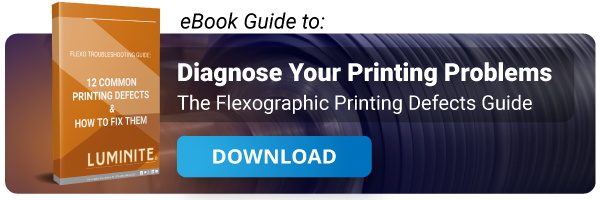Share this
In-The-Round Flexographic Printing Sleeves at FTA Fall Conference 2017
by Luminite on Oct 6, 2017 11:36:15 AM
Flexographic printing sleeves manufactured In-The-Round (ITR) allow for a seamless, continuous print on a variety of substrates.
You need both efficiency and quality. In most industries, those two production results don’t often come in the same combination. However, ITR sleeves, especially those composed of elastomer blends, bring both speed and accuracy needed for perfect, repeatable prints.
We’ve even taken it a step further with the patented Load-N-Lok air sleeve system, which features the following perks seen virtually nowhere else in the flexographic printing sleeve industry:
- Durable elastomer
- Cost savings with very little downtime and waste
- Doesn’t require an air mandrel
- Multiple jobs at once
- Sleeves don’t have to be the same length as your mandrel
The elastomer blend Load-N-Lok and many other flexographic printing products will be on display at the annual Flexographic Technical Association Fall Conference, Oct. 9-11 in St. Louis. We’ll be at booth 217 highlighting printing materials that yield long-lasting quality.
While we’re looking forward to educational sessions on flexo printing processes and networking, take the time to educate yourself on a choice you’ll have to make: elastomer blends vs. photopolymer.
FTA 2017: Elastomer Blends and Photopolymer Flexographic Printing Sleeves
Both have their perks. Here’s a rundown.
Elastomer
Elastomer refers to a variety of polymer composite materials. In general, printing elastomers are tough substances able to be formed into seamless cylinders and imaged by direct laser ablation. Many additional specialized properties are available with different blends. Elastomer's high strength, seamless manufacture, and wide range of properties make it an ideal choice for jobs involving:
- Long runs
- Bright color
- Specialty or adhesive inks
- High accuracy
- Abrasive substrates
- Large format wide web designs
- Varying repeats
- Embossing
- Tight registration
- High temperature
- High solvents
- Conductivity
- Foil stamping
- Lamination
Photopolymer
Photopolymer is a class of materials that change their solubility properties through exposure to ultraviolet (UV) light. Printing photopolymers are manufactured as a flat plate and imaged through a UV exposure-washout process. Plates can be adhered to a printing sleeve permanently during manufacture, or can be mounted by use of a sticky back at press. Photopolymer is often a good choice for work involving:
- Faster turnaround
- Many design changes
- Short one time runs
- Light vignettes
FTA 2017: Choosing Your ITR Flexographic Printing Sleeves
Consider the variables in your printing project. Do you have a job requiring shorter runs and frequently changing images (for instance, product labels with special promotions)? Then a photopolymer sleeve may be best. Do you have a job requiring laying an adhesive on a continuous foil substrate? Then an elastomer blend sleeve may work better.
Do your homework. Ask questions. We’ll be at booth 217 at FTA to help.
Share this
- Flexographic Printing (81)
- Image Carrier (28)
- Elastomer sleeves (27)
- Ink Transfer (25)
- Quality (22)
- Flexo sleeve (20)
- News (18)
- printing defects (18)
- flexo printing defects (17)
- sustainability (13)
- Flexo Troubleshooting (12)
- Ink (12)
- Digital Printing (10)
- Flexo 101 (10)
- Flexo Inks, (9)
- Anilox (7)
- Blister Packaging (7)
- Cost (6)
- print misregistration (6)
- regulations (6)
- Corrugated Printing (4)
- pinholing (4)
- "Tradeshow (3)
- Digital Flexo (3)
- Gravure Printing (3)
- Insider (3)
- Load-N-Lok (3)
- Wide Web (3)
- direct laser engraving (3)
- flexo-equipment-accessories (3)
- gear marks (3)
- halo (3)
- testing (3)
- Narrow Web (2)
- bridging (2)
- feathering (2)
- filling in (2)
- mottled image (2)
- pressure (2)
- Labelexpo (1)
- dirty prints (1)
- doughnuts (1)
- embossing (1)
- kiss impression (1)
- October 2023 (2)
- September 2023 (1)
- August 2023 (1)
- July 2023 (3)
- June 2023 (1)
- May 2023 (5)
- April 2023 (1)
- March 2023 (2)
- February 2023 (1)
- January 2023 (3)
- December 2022 (1)
- October 2022 (3)
- September 2022 (2)
- August 2022 (2)
- July 2022 (3)
- May 2022 (1)
- April 2022 (4)
- March 2022 (2)
- February 2022 (5)
- January 2022 (7)
- December 2021 (1)
- November 2021 (3)
- October 2021 (2)
- September 2021 (1)
- August 2021 (1)
- July 2021 (3)
- June 2021 (1)
- May 2021 (4)
- April 2021 (4)
- March 2021 (4)
- February 2021 (2)
- December 2020 (1)
- November 2020 (1)
- October 2020 (2)
- September 2020 (1)
- August 2020 (3)
- July 2020 (2)
- June 2020 (3)
- May 2020 (1)
- April 2020 (1)
- November 2019 (3)
- October 2019 (1)
- August 2019 (1)
- July 2019 (1)
- April 2019 (1)
- March 2019 (1)
- January 2019 (1)
- October 2018 (2)
- August 2018 (1)
- July 2018 (1)
- June 2018 (1)
- February 2018 (2)
- October 2017 (1)
- September 2017 (2)
- January 2016 (1)
- February 2015 (1)
- January 2015 (1)
- December 2014 (2)
- September 2014 (1)
- February 2014 (1)
- January 2014 (1)
- December 2013 (3)
- October 2013 (1)
- September 2013 (1)
- June 2013 (1)
- January 2013 (1)



Comments (1)